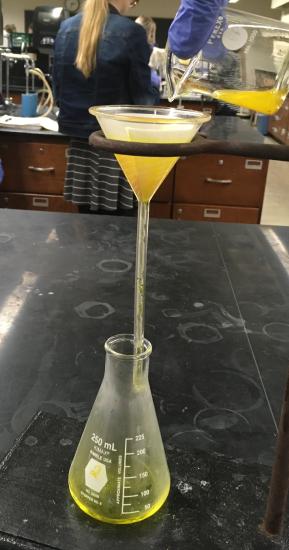4: Determination of a Solubility Constant
- Page ID
- 204128
Objectives
- To investigate two slightly soluble salts and experimentally determine the value of \({K_{sp}}\)
The solubility product constant, \(K_{sp}\), is the equilibrium constant for a solid substance dissolving in an aqueous solution. It represents the level at which a solute dissolves in solution. The more soluble a substance is, the higher the \(K_{sp}\) value it has.
Consider the general dissolution reaction below (in aqueous solutions):
\[ aA_{(s)} \rightleftharpoons cC_{(aq)} + dD_{(aq)} \tag{1} \]
To solve for the \(K_{sp}\) it is necessary to take the molarities or concentrations of the products (cC and dD) and multiply them. If there are coefficients in front of any of the products, it is necessary to raise the product to that coefficient power (and also multiply the concentration by that coefficient). This is shown below:
\[ K_{sp} = [C]^c [D]^d \tag{2}\]
Note that the reactant, aA, is not included in the \(K_{sp}\) equation. Solids are not included when calculating equilibrium constant expressions, because their concentrations do not change the expression; any change in their concentrations are insignificant, and therefore omitted. Hence, \(K_{sp}\) represents the maximum extent that a solid that can dissolved in solution.
The term "insoluble" does not mean that no dissolution takes place. Instead, the amount is considered negligible in relationship to the amount of solid present. However, the amount that does dissolve can often be measured. In this laboratory, the amount of \(\ce{Pb_{2+}}\) in a \(\ce{PbCl_{2}}\) solutions will be determine through the precipitation of \(\ce{PbCrO_{4}}\).
Pre Lab Video
Procedure
Safety And Waste Disposal
- Chromate salts are known carcinogens. They are also corrosive and can cause burns.
- Use gloves and aprons in addition to protective eyewear. Wash hands thoroughly before leaving the lab.
- All solutions and solid wastes (filter paper, paper towels, gloves) should be collected in the appropriate waste container.
Step 1
Prepare a piece of filter paper for filtration (fold according to your Lab Handbook).
Step 2
 Place the filter paper in a clean, dry 250 mL beaker. Label the beaker with the yellow marking pencil with your name and lab section. The marking pencils are by the oven.
Place the filter paper in a clean, dry 250 mL beaker. Label the beaker with the yellow marking pencil with your name and lab section. The marking pencils are by the oven.
Step 3
Weigh the beaker with the filter paper and record the mass to 2 decimal places.
Step 4
Measure 25.0 mL of the saturated lead chloride solution into a graduated cylinder. DO NOT DISTURB THE SOLID ON THE BOTTLE. Be sure that there is no solid in the solution that you pour out. Pour into a 100 mL beaker. Record the actual volume you obtain.
Step 5
Add about 5 mL of the 0.5M sodium chromate solution to the 100 mL beaker.
Step 6
Stirring often, heat the solution gently close to the boiling point.
Step 7
Remove beaker from the heat and let the precipitate settle. Prepare for filtration by taking the piece of filter paper out of the beaker and putting it in a funnel on a ring stand.
Step 8
 Filter the supernatant into an Erlenmeyer flask. The solution does not need to be completely cool before filtering. Transfer the precipitate to the funnel, washing the beaker at least 3 times with small amounts of water and adding this to the funnel. Be sure to get all of the precipitate out of the 100 mL beaker.
Filter the supernatant into an Erlenmeyer flask. The solution does not need to be completely cool before filtering. Transfer the precipitate to the funnel, washing the beaker at least 3 times with small amounts of water and adding this to the funnel. Be sure to get all of the precipitate out of the 100 mL beaker.
Step 9
When the liquid has completely drained, carefully place the filter paper in the beaker you weighed and place it in the oven.
Step 10
Dispose of the filtrate in the appropriate waste bottle.
Step 11
After 45 minutes, remove the beaker from the oven and allow it to cool.
Step 12
Reweigh the beaker with the filter paper and precipitate. Record the mass.
Step 13
Dispose of the filter paper in the appropriate waste container.
Calculations
For each of the calculations, include both the formula used and sample calculation.
Step 1
Calculate the moles of lead (II) chromate produced.
Step 2
Assuming that the lead chromate will not re-dissolve, how many moles of lead ion were in your lead (II) chloride solution? What was its concentration?
Step 3
What is the concentration of chloride ion in the lead (II) chloride solution?
Step 4
What is the Ksp of lead chloride based on your data?

